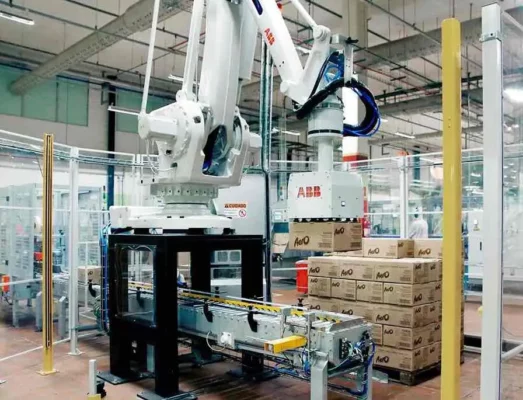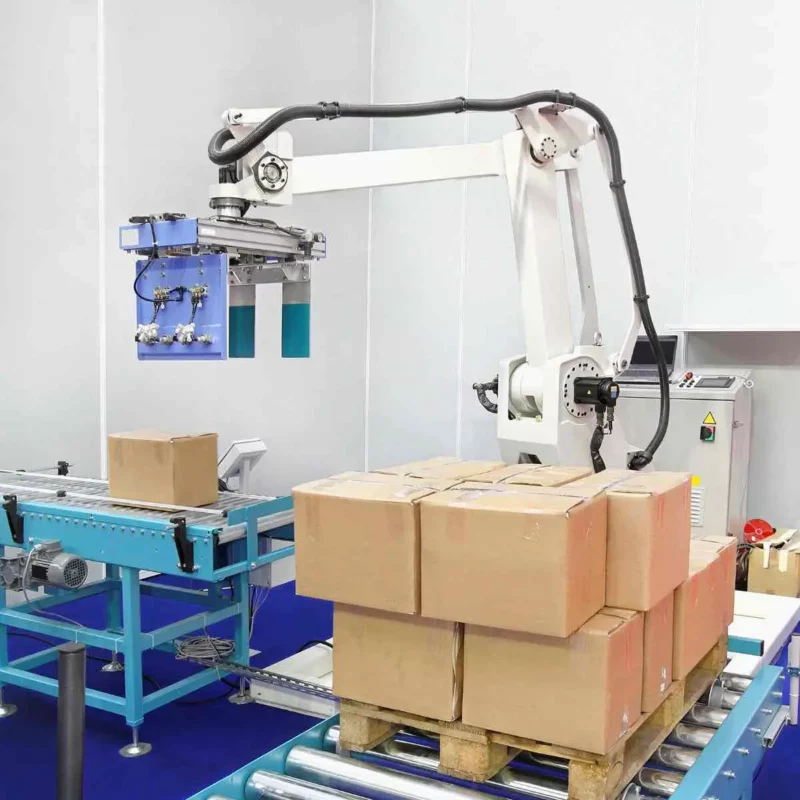Palletizing is crucial in modern manufacturing and logistics. It involves stacking products onto pallets for easy transport and storage. Initially done manually, technology has now introduced automated systems, greatly enhancing productivity and safety. Whether you handle boxes, bags, or irregularly shaped items, understanding various palletizing methods and equipment is key.
In this guide, we’ll dive into the benefits, types, and how to choose the right palletizing system for your needs. This knowledge will help you improve your operations and ensure your products are handled efficiently and safely.
What is Palletizing?
Definition of Palletizing:
Palletizing is the process of stacking and securing products onto a pallet. This method makes transporting and storing goods easier and safer. You arrange items in a way that maximizes space and ensures stability. Palletizing can be done by hand or with machines.
Evolution of Palletizing:
Palletizing started as a manual job. Workers physically loaded and stacked items onto pallets. This was tough, time-consuming work. In the 1950s, automated palletizers were introduced. These machines used simple mechanics to stack items, making the process faster and safer. Over time, technology improved. Now, we have advanced robotic and inline palletizers that handle various products with high precision.
Role of Palletizing in Modern Manufacturing:
Automated systems boost your productivity and safety. They handle different products, from boxes to oddly shaped items, with little human help. This reduces errors and injuries. Automated palletizers can work continuously, cutting downtime and keeping your operations running smoothly.
Robotic palletizers are especially useful. They adapt to different product shapes and weights. This flexibility is vital for industries like food and beverage, pharmaceuticals, and consumer goods. These industries often deal with many product types and packaging standards. Using robotic palletizers, you can ensure that your products are stacked correctly and securely.
Palletizing Process:
Step-by-Step Guide:
- Product Preparation: Ensure your products are correctly packaged and ready for stacking.
- Conveyor Transport: Use conveyors to move products to the palletizing area.
- Stacking: Arrange products on the pallet in a stable pattern using robotic or manual methods.
- Securing: Wrap the palletized load with stretch film to secure items in place.
- Labeling: Apply labels for identification and tracking.
Best Practices:
- Uniform Stacking: Ensure even distribution of weight to prevent toppling.
- Proper Wrapping: Use multiple layers of stretch wrap for stability.
- Regular Maintenance: Keep your palletizing equipment in good condition to avoid downtime.
Common Challenges & Solutions:
- Product Slippage: Use anti-slip sheets between layers.
- Inconsistent Load Heights: Program your robotic palletizer to adjust for varying product heights.
- Equipment Downtime: Schedule regular maintenance and inspections to keep your system running smoothly.
Types of Palletizing:
1. Manual Palletizing:
Manual palletizing involves workers physically stacking and securing products onto pallets. This method relies entirely on human labor. You might find it suitable for small-scale operations or when dealing with fragile items that need careful handling.
Advantages:
- Flexibility: You can handle various product shapes and sizes easily.
- Low Initial Cost: No need for expensive machinery.
- Precision: Ideal for delicate items that require careful placement.
Limitations:
- Labor-Intensive: Requires significant manual effort.
- Inconsistent Quality: Human error can lead to uneven stacking.
- Safety Risks: Higher chances of injuries from repetitive motions and heavy lifting.
2. Semi-Automatic Palletizing:
Semi-automatic palletizing combines your manual labor with some automation. A machine helps with stacking, but you or your workers still handle part of the process. This approach boosts your efficiency without full automation.
First, a conveyor system moves products to a designated area. You or your workers then manually arrange the products. Next, a machine stacks and secures the products onto pallets.
Pros:
- Increased Efficiency: Speeds up the palletizing process.
- Reduced Labor: Less physical effort required from workers.
- Cost-Effective: More affordable than full automation.
Cons:
- Partial Automation: Still requires manual input.
- Limited Speed: Not as fast as fully automated systems.
- Maintenance: Machines require regular upkeep.
3. Automatic Palletizing:
Automatic palletizing uses advanced machinery to handle the entire stacking process. This method is highly efficient and ideal for large-scale operations. There are two main types: robotic and inline palletizers.
Robotic Palletizers:
- Use robotic arms to pick and place products onto pallets.
- Suitable for handling diverse product types and sizes.
- Highly flexible and programmable for different tasks.
Inline Palletizers:
- Best for uniform products like boxes and cans.
- Utilize conveyor belts to move and stack items in a fixed pattern.
- Fast and efficient for high-volume production lines.
Benefits:
- High Speed: Significantly increases palletizing speed.
- Consistent Quality: Ensures uniform stacking every time.
- Reduced Labor Costs: Minimal human intervention required.
- Enhanced Safety: Lowers risk of workplace injuries.
Types of Automated Palletizers:
Robotic Palletizers:
Robotic palletizers use robotic arms to stack your products onto pallets. These systems are highly versatile and can handle different shapes and sizes. The robotic arm picks items from a conveyor and places them on the pallet according to a programmed pattern. The robotic arm has an End-of-Arm Tool (EoAT) customized for your product. Advanced sensors guide the arm to pick and place items accurately. You can program the system to handle various stacking patterns and pallet configurations.
Typical Applications:
- Ideal for industries with diverse product lines, such as food and beverage, pharmaceuticals, and consumer goods.
- Perfect for handling fragile or irregularly shaped items.
- Used in environments where flexibility and quick changeovers are essential
Inline Palletizers:
Inline palletizers are perfect for your high-speed production lines. They work best with uniform products like boxes, cans, or bags. These systems use conveyors to move products into a fixed stacking pattern. Products move along a conveyor belt and are automatically arranged into rows. The system then stacks these rows onto a pallet precisely. Inline palletizers are usually faster than robotic palletizers but offer less flexibility.
Ideal Uses:
- Suitable for industries with high-volume, consistent product sizes, such as beverage bottling and canned goods.
- Best for applications where speed and efficiency are crucial.
- Not ideal for handling varied or irregularly shaped items.
Comparison with Robotic Palletizers:
- Inline palletizers are faster for uniform products but lack the flexibility of robotic systems.
- Robotic palletizers can handle a wider range of products but may operate at a slower speed compared to inline systems.
Mixed Load Palletizers:
Mixed load palletizers can handle different products on the same pallet, combining features of both robotic and inline systems for maximum flexibility and efficiency. These systems stack various product types together on a single pallet using advanced software to plan and execute complex stacking patterns. They are ideal for your industry if you need to palletize mixed product loads for customized orders.
Benefits:
- High flexibility: Can handle diverse product sizes, shapes, and weights.
- Efficiency: Streamlines the palletizing process for mixed loads, reducing the need for manual intervention.
- Cost savings: Reduces labor costs and improves overall productivity.
Use Cases:
- Perfect for e-commerce and retail distribution centers where orders often include mixed products.
- Useful in manufacturing environments with diverse product lines.
- Enhances operational efficiency by reducing the need for multiple palletizing systems.
Benefits of Automated Palletizing:
1. Efficiency:
Palletizing significantly boosts operational efficiency. Automated systems streamline the stacking process, allowing you to handle more products in less time. This speeds up production and ensures a consistent workflow, reducing bottlenecks and increasing overall productivity.
2. Safety:
Palletizing reduces workplace injuries. By automating the stacking process, you minimize the physical strain on your workers. This decreases the risk of injuries related to heavy lifting and repetitive tasks, creating a safer work environment.
3. Cost Savings:
Automated palletizing lowers labor costs. Fewer manual tasks mean you can allocate your workforce to more valuable activities. Additionally, efficient palletizing reduces shipping costs by optimizing load stability and space utilization on pallets.
4. Product Integrity:
Palletizing ensures the protection of goods during transit. Properly stacked and secured products are less likely to shift or get damaged. This maintains product integrity and reduces losses from damaged goods, ensuring your products reach their destination in perfect condition..

Palletizing Equipment & Technologies:
Key Components:
To optimize your palletizing process, you need to understand the key components. Conveyors are crucial as they transport products to the palletizing area efficiently. Robots, equipped with specialized End-of-Arm Tools (EoAT), do the heavy lifting by stacking items onto pallets. Wrapping machines then secure the stacked products with stretch wrap, ensuring stability and protection during transit.
Technological Advancements:
Technological advancements have revolutionized palletizing. AI and machine learning enhance the precision and adaptability of robotic systems. These technologies allow robots to handle a wider variety of products with greater accuracy. Additionally, advanced sensors and vision systems enable robots to identify and stack products optimally. The integration of IoT connectivity offers real-time monitoring and predictive maintenance, boosting the reliability and efficiency of your palletizing operation.
Comparing Brands:
When selecting palletizing equipment, it’s essential to compare leading brands. FANUC robots are renowned for their reliability and speed, making them ideal for high-volume operations. ABB provides solutions that prioritize safety and user-friendliness, which can be crucial if you’re new to automation. KUKA stands out for its innovative technologies and robust performance, perfect for demanding environments. Each brand offers unique benefits, so consider your specific needs and operational goals when making your choice
Choosing the Right Palletizer:
Factors to Consider:
When selecting a palletizer, you need to consider your product type, volume, and budget. Think about the nature of your products—are they uniform boxes or irregularly shaped items? High-volume operations benefit from fast inline palletizers, while smaller, varied product lines may require versatile robotic systems. Balancing your budget with long-term savings is also crucial.
Customization Options:
Every industry has unique requirements. For example, if you’re in the food and beverage industry, you might need palletizers that handle delicate packaging. In pharmaceuticals, maintaining strict hygiene standards is essential. Customizable palletizing solutions can be tailored to your specific needs, ensuring optimal performance and compliance with industry standards.
Conclusion:
Investing in a palletizing system can transform your manufacturing and logistics. By understanding the types of palletizers and their benefits, you can make smart choices to boost efficiency, safety, and savings. Automated systems streamline your processes, reduce labor costs, and increase productivity, providing a solid return on investment. Explore financing and leasing options to manage initial costs. By integrating modern palletizing technology, you ensure your operations stay competitive and efficient.






